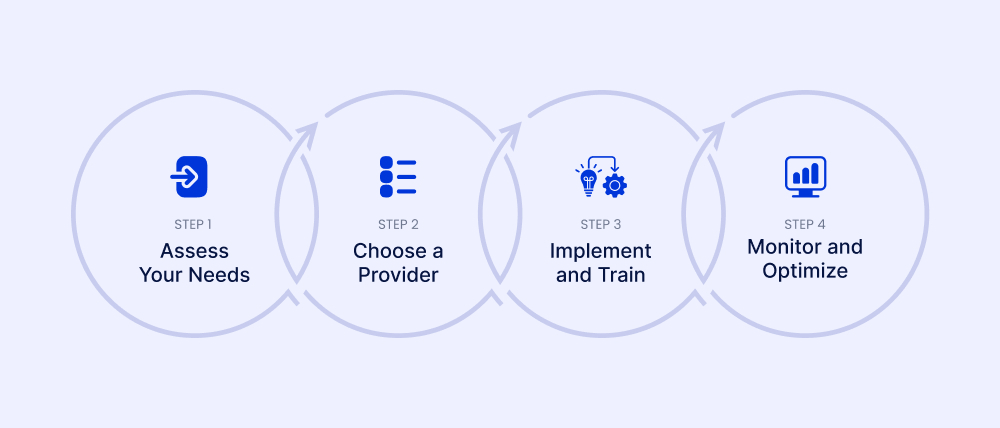If you are one of the 358 million small and medium-sized businesses (SMBs) in the world, you know your growth relies heavily on seamless customer interactions. This means, when it comes to communication infrastructure, you can’t afford to go wrong.
A robust phone system can be the difference between delighting your customers and lost opportunities.
While traditional phone systems have served businesses for decades, VoIP (Voice over Internet Protocol) is emerging as the smarter, more efficient choice. This is because of its ability to make better quality calls at lower costs with the help of the Internet. Other than that, its flexibility, scalability, and omnichannel functionality are the cherries on the cake.
Let’s understand why SMBs should opt for VoIP vs Traditional Phone System.
Challenges of Traditional PBX Phone System for Small Business
Despite its historical reliability, a traditional pbx phone system for small business comes with a set of limitations. Some of those make these solutions less suited for today’s working environment.
For example, traditional phones rely on outdated infrastructure, which often leads to high maintenance costs and frequent breakdowns. They also lack the flexibility to support hybrid team setups, leaving your teams unable to operate efficiently.
Let’s understand these challenges in detail:
Sky-high Phone Bills
Traditional systems rely heavily on physical infrastructure like phone lines and calling equipment. As a result, they often incur high costs due to long-distance charges, maintenance fees, and outdated infrastructure. Other than that, adding new lines or features typically requires additional hardware investments, further increasing costs.
As an SMB, operating on a limited budget, you may find these expenses unsustainable.
Long List of Missed Calls
During peak shopping seasons, like the holidays, limited phone lines can be a recipe for disaster. Constantly busy phone lines can cost you many great business opportunities.
Without advanced features like call routing, voicemail-to-email, or automated attendants, managing call volume becomes a daunting task. This can frustrate customers and negatively affect your team’s morale.
Remote Work Demands
Traditional pbx phone systems for small business struggle to support remote communication. They lack the flexibility to allow employees to work effectively from any location, creating roadblocks in maintaining productivity and customer satisfaction. The inability to integrate with modern collaboration tools like CRMs and ERPs further hampers their utility for hybrid or remote teams.
VoIP Phone System for Small Business
VoIP systems use the Internet to make and receive calls, offering a range of advanced features tailored to your business needs. You get HD calling, instant messaging, video conferencing, and more, all from a single platform.
But how is it beneficial for a small business?
First, they help you interact with your customers from whichever channel they prefer. You can seamlessly take an ongoing voice call to a video call without disturbing the flow. Or you can share a document on text while explaining the details over call. This helps you give your customers a delightful experience.
Another, arguably the most important advantage you get, is massive cost savings. According to a recent study, switching to VoIP phone system for small business resulted in 30% savings on the phone bill.
Other than that, with functionalities like call forwarding, auto-attendants, CRM integration, and advanced analytics, VoIP can transform how you communicate. It adapts seamlessly to the needs of growing businesses, offering flexibility and scalability without any major infrastructural changes.
Discover the Freedom of VoIP for Small Business
Switching to a VoIP phone system for small business has multiple advantages. Here are a few of them:
Cost-Effective Phone Systems
VoIP phone systems offer a comprehensive communication platform at affordable prices. If you choose a good provider, you get cost-effective call rates, predictable monthly pricing, and subscription-based models, making budgeting more manageable. Some providers, like Acefone, go a step further and include regular updates and support.
Multi-Line Phone System for Business
VoIP-based phone lines are easy to set up and don’t require hefty infrastructure. They can help you handle multiple calls simultaneously, ensuring no customer is left waiting. Features like call queuing, conferencing, and advanced call routing you can provide exceptional service, even during high-demand periods. You also get device-independent extensions for employees, enhancing internal communication efficiency.
Future-Proof PBX Solutions for Small Business
Most of the VoIP solutions today offer a cloud based phone system. It reduces maintenance requirements and ensures your system is accessible from anywhere with an internet connection.
Moreover, the systems are scalable, allowing you to add or remove lines as needed without significant investments. They integrate easily with other software, such as customer relationship management (CRM) platforms, ensuring your communication infrastructure evolves alongside your business. As technology advances, VoIP providers continually enhance their offerings, keeping you ahead of the curve.
Taking Your First Steps to a VoIP Phone System for Small Business

So far, we have established that VoIP phone systems for small businesses are better than landlines. You might be wondering how to find the right provider and implement the new system seamlessly.
Here are some simple steps to help you get started:
Step 1: Assess Your Needs
Implementing any new solution requires analyzing the shortcomings of your existing system. Start by ascertaining your specific business requirements. Identify the following key factors:
- Number of Users: Determine how many employees will need access to the system and the specific roles that require advanced features like call analytics or recording.
- Features: Outline the must-have features like call forwarding, voicemail-to-email, conferencing, or CRM integration, based on your operational needs.
- Budget: Determine your budget, factoring in both set-up costs and recurring charges. Consider how the solution’s cost-effectiveness aligns with your growth goals. Other than that, make sure your solution provider offers flexible plans. This way you can alter the services as needed.
- Operational Aspects: Account for call volume, expected growth, remote work requirements, and the need for seamless integration with your existing tools.
Step 2: Choose a Provider
Once you have analyzed your needs, it’s time to hit the market and find the most suitable provider. Here are the key factors you should consider:
- Reputation and Reviews: Investigate the provider reviews, testimonials, and case studies. This will help you gauge their reputation for delivering quality services.
- Customer Support: Look for 24/7 support with knowledgeable representatives who can assist with technical issues.
- Packages for SMBs: Ensure the provider offers flexible plans tailored to small and medium businesses, with scalable options for future growth.
- Feature Analysis: Compare features like call analytics, AI-driven tools, multi-channel communication, and security measures to match your requirements.
Step 3: Implement and Train
The factors mentioned above will help you find the right provider. Next comes implementation.
Collaborate with your chosen provider to ensure a smooth installation and configuration process. Take care of:
- Setup Assistance: Take full advantage of the onboarding support offered by your provider to ensure the system is tailored to your business. This may include configuring call flows, user permissions, and integrations.
- Training Resources: Arrange training sessions for your team to familiarize them with the system’s features. Many providers offer tutorials, webinars, and comprehensive manuals to streamline learning.
- Change Management: Communicate the benefits of the new system to your team to encourage adoption and address any initial challenges effectively.
Step 4: Monitor and Optimize
After the implementation, focus on monitoring and refining the setup to maximize ROI.
Here’s how you can ensure proper monitoring:
- Use Analytics: Monitor call data and usage patterns to identify bottlenecks or areas for improvement.
- Gather Feedback: Regularly collect feedback from employees and customers to fine-tune system performance.
- Explore Advanced Features: Stay updated on new features or upgrades offered by your provider that can enhance communication efficiency.
- Regular System Reviews: Schedule periodic reviews to ensure the system continues to meet your evolving business needs and remains scalable as you grow.
Final Words
As a small business, relying on a traditional phone system to manage interactions is costing you precious opportunities. Your customers expect nothing less than the best in terms of timely and efficient responses. To fulfill their expectations, your team needs technology, which is futuristic, yet easy to use—VoIP phone system.
Now that you’re aware of the advantages of a voip for small businesses, the experts at Acefone are here to help you further. We can help you find out how our next-gen communication suite could double your efficiency while keeping costs in check.














